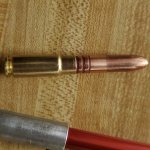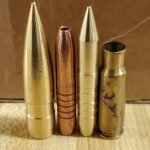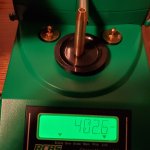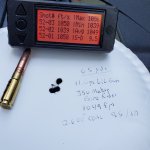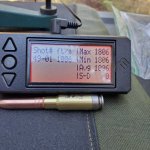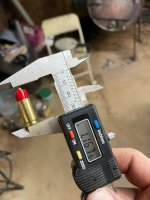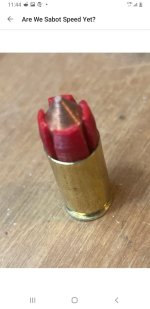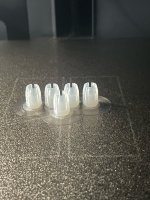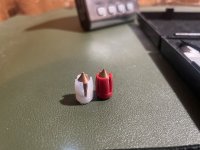If 2 bullets have the same weight but different diameters, does one have a higher velocity over the other? For example: 6ARC vs 6.5 Grendel or 22CM vs 6CM or 6CM vs 6.5CM. I think I read somewhere that the larger diameter bullet would have a higher velocity assuming all other variables were equal (barrel length, charge weight, etc.). Can someone help explain this?
Join the Hide community
Get access to live stream, lessons, the post exchange, and chat with other snipers.
Register
Download Gravity Ballistics
Get help to accurately calculate and scope your sniper rifle using real shooting data.

Install the app
How to install the app on iOS
Follow along with the video below to see how to install our site as a web app on your home screen.
Note: This feature may not be available in some browsers.
You are using an out of date browser. It may not display this or other websites correctly.
You should upgrade or use an alternative browser.
You should upgrade or use an alternative browser.
Bullet Diameter vs Velocity
- Thread starter TN Shooter
- Start date
The larger diameter offers more surface area upon with the pressure/force can act and so it accelerates more rapidly than an equivalent weight bullet in a smaller diameter.
Force = Pressure X Area. Assuming identical pressure curves, the larger diameter bullet is being acted on by a larger force.
Keep in mind that for identical case volumes the larger diameter bullet will require a faster burning powder to achieve that identical pressure curve (more bore volume for the same amount of bullet movement).
Keep in mind that for identical case volumes the larger diameter bullet will require a faster burning powder to achieve that identical pressure curve (more bore volume for the same amount of bullet movement).
You didn’t really think this comment through if your argument is that more acceleration won’t result in velocity.Being pedantic, the OP asked about velocity, not acceleration. Also, the more surface area, the higher the drag.
What are we trying to solve?
Besides, I have yet to encounter all other variables being equal.
If 2 projectiles leave their barrels at the same velocity, they are flying through the air at the same velocity at that moment regardless of diameter or weight or mass or sectional density or coefficient of drag or direction of fire or any other factor you might dream up.
Think about that for a minute...You didn’t really think this comment through if your argument is that more acceleration won’t result in velocity.
A VW Beetle accelerates slowly to a final velocity of 80 mph in 60 seconds.
A Ford Pinto accelerates faster to that final velocity of 80 mph in 30 seconds.
What is the velocity of each vehicle?
The question is not well formulated. Think this through and ask a better question.If 2 bullets have the same weight but different diameters, does one have a higher velocity over the other? For example: 6ARC vs 6.5 Grendel or 22CM vs 6CM or 6CM vs 6.5CM. I think I read somewhere that the larger diameter bullet would have a higher velocity assuming all other variables were equal (barrel length, charge weight, etc.). Can someone help explain this?
I suppose I should have left out the “all other variables” part of my post. All I’m wondering is how velocity compares between 80gr ELD (22 CM) and 80gr ELD-VT (6CM).The question is not well formulated. Think this through and ask a better question.
So assuming the same barrel lengths, do lighter bullets (thinking of ELD-VT)in 6.5 Grendel, 6 CM, and 6.5 CM tend to have a higher velocity than the same or similar weight bullets in 6ARC, 22 CM, and 6 CM respectively?
And you expect the one that hit it quicker to just flatline its acceleration?Think about that for a minute...
A VW Beetle accelerates slowly to a final velocity of 80 mph in 60 seconds.
A Ford Pinto accelerates faster to that final velocity of 80 mph in 30 seconds.
What is the velocity of each vehicle?
Think about that for a minute...
A VW Beetle accelerates slowly to a final velocity of 80 mph in 60 seconds.
A Ford Pinto accelerates faster to that final velocity of 80 mph in 30 seconds.
What is the velocity of each vehicle?
This is a terrible example to compare to bullet velocity and acceleration for too many reasons worth listing.
And you expect the one that hit it quicker to just flatline its acceleration?
In his example sure......
He just failed to realize bullets don't have brakes and/or the ability to reduce combustion whenever they want.
Generally, yes. You can see this play out in the loading data as well. For a wider window of bore size with identical cases, check out data for the .243 win, 260 rem, 7-08 rem, .308 win.I suppose I should have left out the “all other variables” part of my post. All I’m wondering is how velocity compares between 80gr ELD (22 CM) and 80gr ELD-VT (6CM).
So assuming the same barrel lengths, do lighter bullets (thinking of ELD-VT)in 6.5 Grendel, 6 CM, and 6.5 CM tend to have a higher velocity than the same or similar weight bullets in 6ARC, 22 CM, and 6 CM respectively?
Think about that for a minute...
A VW Beetle accelerates slowly to a final velocity of 80 mph in 60 seconds.
A Ford Pinto accelerates faster to that final velocity of 80 mph in 30 seconds.
What is the velocity of each vehicle?
That depends on the location of the unit measuring velocity.
Is it at speed or at a place before final speed is reached?
Since your question asked for velocity, then it's 80mph. If one was to measure in meters per second, feet per second, furlongs per second or even skittles per second, all of it can be mathed out, knowing the 80mph velocity.
Acceleration rate is a different animal. Look at the cheetah and the pronghorn antelope. Both can reach 50 mph with ease. Their acceleration rates probably differ. Also, the pronghorn can maintain the 50mph for a much longer time.
It's got a much better BC...
One, er two words, bore rider. I think Barnes or Berger one makes some... the main body of the projectile rides on the lands and has bands or a fatter portion at the rear that engages the rifling. Less contact, less friction, and for solid copper's especially since they have more friction typically than lead core jacketed designs, that's a good thing, helps keep pressures for similar weight lead core projectiles and solid coppers more close if everything else was equal (like the powder charge and projectile weight) and MAY make them faster than their lead core counter parts? I'd wager makes them faster than their solid copper cousins that have a lot more engagement area for sure.
Last edited:
That's because the larger diameter bullet, with all other things being equal will generate a different and higher pressure curve.I have noticed a significant difference in velocity between bullets in .44mag. A bullet that is .001 larger will have a higher velocity with all other things being pretty much the same.
There is but one question to be answered and it is a very simple answer without any convoluted and irrelevant wanderings.That depends on the location of the unit measuring velocity.
Is it at speed or at a place before final speed is reached?
Since your question asked for velocity, then it's 80mph. If one was to measure in meters per second, feet per second, furlongs per second or even skittles per second, all of it can be mathed out, knowing the 80mph velocity.
Acceleration rate is a different animal. Look at the cheetah and the pronghorn antelope. Both can reach 50 mph with ease. Their acceleration rates probably differ. Also, the pronghorn can maintain the 50mph for a much longer time.
It's got a much better BC...
Name a few.This is a terrible example to compare to bullet velocity and acceleration for too many reasons worth listing.
The point being made, and it is 100% relevant, is that velocity is independent of how it was achieved or how soon it was achieved or where it was achieved or what is traveling at that velocity.
Sure...go ahead and add in other shit like atmospherics and whatever but the fact remains.
I suppose I should have left out the “all other variables” part of my post. All I’m wondering is how velocity compares between 80gr ELD (22 CM) and 80gr ELD-VT (6CM).
So assuming the same barrel lengths, do lighter bullets (thinking of ELD-VT)in 6.5 Grendel, 6 CM, and 6.5 CM tend to have a higher velocity than the same or similar weight bullets in 6ARC, 22 CM, and 6 CM respectively?
I'm gonna go out on a limb here and just say it.
Stop worrying about all of this velocity stuff. A difference of 50fps doesn't make much difference in the real world.
A bullet diameter by itself doesn't make for more or less velocity. It is all dependant on the brass, the primer, the powder, the barrel and even the outside temperature.
With that said, if you could duplicate everything down to the barrel length, powder charge, and velocity per inch of barrel length, then yes, the 224 diameter bullet will go faster, simply because it generates more pressure in the smaller bore.
I have an experiment for you that will help you understand how this works.
Swing by your nearest Burger King AND McDonalds.
Grab a straw from each place.
Note the McD straw is larger in diameter. That's your 6mm barrel.
The BK straw is your 224 barrel.
Now, take two good strips of napkin, identical in size. Make a tight fitting spitwad from each of them and place it into their respective straws.
Huff and puff and blow that 6mm Micky Ds spitwad.
Now, pick up the 224 BK spitwad and do the same thing.
Note the difference in back pressure generated from each straw/spitwad combo.
Both spitwads should have gone out at the same velocity, but they didn't. The BK, higher backpressure spitwad represents what it takes to make the two spitwad bullets accelerate to their maximum velocity.
You didn't use more lung capacity. You didn't huff and puff longer. You simply needed more pressure to get the spitwad out of the straw.
You felt the difference in your cheeks.
Your cheeks represent the piezoelectric transducer the measures pressure in the chamber and down the barrel until the bullet exits.
It's simple physics
Again...not well formulated or maybe you do not understand that 2750 fps with an 80 gr ELD is the same 2750 fps with an 80 gr ELD-VTI suppose I should have left out the “all other variables” part of my post. All I’m wondering is how velocity compares between 80gr ELD (22 CM) and 80gr ELD-VT (6CM).
So assuming the same barrel lengths, do lighter bullets (thinking of ELD-VT)in 6.5 Grendel, 6 CM, and 6.5 CM tend to have a higher velocity than the same or similar weight bullets in 6ARC, 22 CM, and 6 CM respectively?
There is but one question to be answered and it is a very simple answer without any convoluted and irrelevant wanderings.
Look, the entire premise of this thread is a time waster.
Your question on velocity of two vehicles was no less convoluted and equally irrelevant.
I love answering silly questions with equally (or worse) silly answers.
You don't have to read them.
And you expect the one that hit it quicker to just flatline its acceleration?
Think about that for a minute...
A VW Beetle accelerates slowly to a final velocity of 80 mph in 60 seconds.
A Ford Pinto accelerates faster to that final velocity of 80 mph in 30 seconds.
What is the velocity of each vehicle?
I agree his question isn't super clear, but you can see where’s he’s going. You changed his question. His question isnt what will these bullets do at the same speed as one another. Its will a 80 vt in a 6cm be faster than the 80 eld in a 22 cm. A bunch of variables aside, the simple answer is yes. To what degree depends on the variables of course.Again...not well formulated or maybe you do not understand that 2750 fps with an 80 gr ELD is the same 2750 fps with an 80 gr ELD-VT
Because the Pronghorn is made in Merica damnit and the lazy ass cheetah is african.That depends on the location of the unit measuring velocity.
Is it at speed or at a place before final speed is reached?
Since your question asked for velocity, then it's 80mph. If one was to measure in meters per second, feet per second, furlongs per second or even skittles per second, all of it can be mathed out, knowing the 80mph velocity.
Acceleration rate is a different animal. Look at the cheetah and the pronghorn antelope. Both can reach 50 mph with ease. Their acceleration rates probably differ. Also, the pronghorn can maintain the 50mph for a much longer time.
It's got a much better BC...
Negative. I did NOT change his question to be what either bullet or Pinto or fucking freight train will DO at some given velocity.I agree his question isn't super clear, but you can see where’s he’s going. You changed his question. His question isnt what will these bullets do at the same speed as one another. Its will a 80 vt in a 6cm be faster than the 80 eld in a 22 cm. A bunch of variables aside, the simple answer is yes. To what degree depends on the variables of course.
"A bunch of variables aside" that is maybe the most misunderstood part of what he is asking.
Can a 6CM shoot the same weight bullet faster than a 22CM? Yes.
Can a 6CM shoot the same weight bullet the same velocity as a 22CM? Yes.
Can a 6CM shoot the same weight bullet with less velocity than a 22CM? Yes.
You're not following, at all. His question is very simple, and has been stated and restated by me and other posters above.Can a 6CM shoot the same weight bullet faster than a 22CM? Yes.
Can a 6CM shoot the same weight bullet the same velocity as a 22CM? Yes.
Can a 6CM shoot the same weight bullet with less velocity than a 22CM? Yes.
Here, i’ll try another way. He’s asking how bore area affects velocity. Thats it, nothing more.
Negative, it's not simply the bore, as that would include length and twist. His question, as faulty as it is posed, is only concerned with DIAMETER. THAT's it...nothing more.You're not following, at all. His question is very simple, and has been stated and restated by me and other posters above.
Here, i’ll try another way. He’s asking how bore area affects velocity. Thats it, nothing more.
And the most correct and extremely simple answer to the question as to whether a small diameter will shoot faster or slower than a larger diameter, using the same lot of powder and charge weight, the same primer...all else being equal, is, simply, MAYBE.
He’s asking how one variable affects velocity, thats it. He notes bullet diameter. We say bore area in the context of the question. No need to keep saying there are other variables, the OP has already demonstrated he understands there are many other variables.Negative, it's not simply the bore, as that would include length and twist. His question, as faulty as it is posed, is only concerned with DIAMETER. THAT's it...nothing more.
And the most correct and extremely simple answer to the question as to whether a small diameter will shoot faster or slower than a larger diameter, using the same lot of powder and charge weight, the same primer...all else being equal, is, simply, MAYBE.
If you look back, go ahead, go look, I am the one that has repeatedly said there are not other variables.He’s asking how one variable affects velocity, thats it. He notes bullet diameter. We say bore area in the context of the question. No need to keep saying there are other variables, the OP has already demonstrated he understands there are many other variables.
Here, let's figure out how to calculate velocity....
Measure the distance traveled then divide by the amount of time it took to travel that distance.
THAT'S IT!! Nothing more.
No BC, no twist rate, no diameter...it doesn't even matter what the object is (car, bullet, bulldozer) nor how it came to be traveling that distance in that amount of time. Not part of the equation, are they?
Simple, really.
Go back a read the Op’s question, he’s not asking about the measurement of velocity. How can you have missed this so many times?If you look back, go ahead, go look, I am the one that has repeatedly said there are not other variables.
Here, let's figure out how to calculate velocity....
Measure the distance traveled then divide by the amount of time it took to travel that distance.
THAT'S IT!! Nothing more.
No BC, no twist rate, no diameter...it doesn't even matter what the object is (car, bullet, bulldozer) nor how it came to be traveling that distance in that amount of time. Not part of the equation, are they?
Simple, really.
You truly might be a fucking idiotGo back a read the Op’s question, he’s not asking about the measurement of velocity. How can you have missed this so many times?
View attachment 8606630
Yall make shit way too hard.
The answer is yes. The larger diameter will be faster at the end of the barrel with equal pressure. It will take more powder to achieve that pressure. The larger bore diameter allows for it while keeping the same pressure. This all enables a higher velocity at the muzzle. Tha rate of gas expansion and all that shit.
The answer is yes. The larger diameter will be faster at the end of the barrel with equal pressure. It will take more powder to achieve that pressure. The larger bore diameter allows for it while keeping the same pressure. This all enables a higher velocity at the muzzle. Tha rate of gas expansion and all that shit.
Area of a 24cal is .046”
Area of a 30cal is .075”
Force=Pressure*Area
If pressure remains the same (60k) then the 24 cal has 2760 units of force and the 30 cal has 4500 units of force acting upon the bullet.
Force=Mass*Acceleration
If mass is the same, more force has a direct relationship to more acceleration.
Area of a 30cal is .075”
Force=Pressure*Area
If pressure remains the same (60k) then the 24 cal has 2760 units of force and the 30 cal has 4500 units of force acting upon the bullet.
Force=Mass*Acceleration
If mass is the same, more force has a direct relationship to more acceleration.
And more acceleration equals a higher final velocity unless you do some amazingly retarded concessions to try to make an incorrect point.
End of the barrels is one thing, at the target is another. The OP's question has too many open variables.If 2 bullets have the same weight but different diameters, does one have a higher velocity over the other? For example: 6ARC vs 6.5 Grendel or 22CM vs 6CM or 6CM vs 6.5CM. I think I read somewhere that the larger diameter bullet would have a higher velocity assuming all other variables were equal (barrel length, charge weight, etc.). Can someone help explain this?
The real world works roughly like this.Yall make shit way too hard.
115 VLD in .257 cal bore ø (G7 .257)
115 VLD in .243 cal bore ø (G7 .289)
130 VLD .270 cal bore ø (G7 .236)
130 VLD .264 cal bore ø (G7 .288)
With common density substrate and common family of bullet design, larger diameters with equal weight are higher drag, lower BC. MV is different, then equal, and then different again (in the opposite way). This is depending on the distance Z velocity is measured from the shooter.
That's probably the simplist answer one can give "without being too simple".
Last edited:
But the larger bore means more area therefore less pressure as the bullet gets further down the bore.Area of a 24cal is .046”
Area of a 30cal is .075”
Force=Pressure*Area
If pressure remains the same (60k) then the 24 cal has 2760 units of force and the 30 cal has 4500 units of force acting upon the bullet.
Force=Mass*Acceleration
If mass is the same, more force has a direct relationship to more acceleration.
But that’s not the issue being posed.But the larger bore means more area therefore less pressure as the bullet gets further down the bore.
That’s simply you choosing the wrong powder.
How big is the difference in fps of mv? Use .243 vs .264 or .264 vs .308. Is it 50 fps? 100 fps?
I suppose I should have left out the “all other variables” part of my post. All I’m wondering is how velocity compares between 80gr ELD (22 CM) and 80gr ELD-VT (6CM).
So assuming the same barrel lengths, do lighter bullets (thinking of ELD-VT)in 6.5 Grendel, 6 CM, and 6.5 CM tend to have a higher velocity than the same or similar weight bullets in 6ARC, 22 CM, and 6 CM respectively?
Itll make more sense when you stop thinkin of strictly bullet weights and more along the lines of bullet weight relative to caliber
80gr in 22cal is on the heavy side for caliber
80gr for 6mm is on the light end
105 for 6mm is on the heavy end
105 for 6.5 is way on the light end
And it keeps scaling as you go up
With equal cartridges, the lighter bullets in the larger bore diameter option will be able to hit higher muzzle velocity before hitting pressure issues w/ appropriate propellants
Or….the upper end (heavy) bullet weights in 22creed, will be slower than the lower end (light) bullet weights of 6creed, and upper end bullet weights of 6creed will be slower than the lower end bullet weights of 6.5creed…at similar given pressures for each respective load
If someone runs a 80gr 22creed @ 70k psi and a 80gr 6creed @ 50k psi…then of course the 22creed might be faster…but that isn’t what you’re asking
And at some point down range, the bullet designs with the higher BCs (usually the heavy for caliber options) can surpass the lower BCs bullets in velocity even tho the ligher/lower BCs bullets started with a higher muzzle velocity
Where that occurs, depends on a handful of factors and is independent for each comparison…if you’re shooting inside 500yds, it’ll likely never happen that soon
Supersubes was on it
Last edited:
According to Hodgdon data, a 308 with the 110 berger flat base will go 3300-3350. A 243 with a 108 eld shows 3000-3050. They both used 24” barrels, various hodgdon powders, and they ran the 243 to a slightly higher pressure on average (~3k psi).How big is the difference in fps of mv? Use .243 vs .264 or .264 vs .308. Is it 50 fps? 100 fps?
Yep I make bore riders to gain extra velocity here is an example 350 gr bullet in a tiny 338 Spectre case at 1114 fps fired in an AR 15.One, er two words, bore rider. I think Barnes or Berger one makes some... the main body of the projectile rides on the lands and has bands or a fatter portion at the rear that engages the rifling. Less contact, less friction, and for solid copper's especially since they have more friction typically than lead core jacketed designs, that's a good thing, helps keep pressures for similar weight lead core projectiles and solid coppers more close if everything else was equal (like the powder charge and projectile weight) and MAY make them faster than their lead core counter parts? I'd wager makes them faster than their solid copper cousins that have a lot more engagement area for sure.
A 750 gr Barnes .510 cal turned into a bore rider .338 or .375 400 gr for a AR platform.
I make or alter bore rider bullets in these designs. It's a very useful design.
To lessen pressure and add more powder for higher velocities with really heavy for caliber bullets...or use tiny cases in ARs to shoot really heavy bullets for more subsonic energy....with a fast twist rate.
Attachments
The larger diameter offers more surface area against the bore increasing friction lossesThe larger diameter offers more surface area upon with the pressure/force can act and so it accelerates more rapidly than an equivalent weight bullet in a smaller diameter.
The larger diameter offers more surface area against the bore increasing friction losses
Maybe. The larger diameter at the same weight may have a shorter bearing surface, possibly enough to negate the circumference difference.
If only there was a website or something where one could find actual data. Oh wait, I pulled up some data from Hodgdon’s website…
22ARC
24” barrel
95 gr bullet
H100V
51,100 psi
2693 fps
6mm ARC
24” barrel
95 gr bullet
CFE223
50,100 psi
2773 fps
6.5 grendel
24” barrel
95 gr bullet
Lever
47,600 psi
2982 fps
Up until you hit the limits of case capacity, you can cram more, and faster burning, powder behind a larger diameter bullet before reaching SAAMI pressure limits.
22ARC
24” barrel
95 gr bullet
H100V
51,100 psi
2693 fps
6mm ARC
24” barrel
95 gr bullet
CFE223
50,100 psi
2773 fps
6.5 grendel
24” barrel
95 gr bullet
Lever
47,600 psi
2982 fps
Up until you hit the limits of case capacity, you can cram more, and faster burning, powder behind a larger diameter bullet before reaching SAAMI pressure limits.
And this is why Sabot ammo exsists and how I was able to push a 41gr solid copper projectile down a 9x19 bore at over 2400fps using a FDM printed sabot. (screw you 5.7 you can’t even do that!)The larger diameter offers more surface area against the bore increasing friction losses
This is how you do it fellas, keep the area, just lower the total mass… the right way. Keeping surface area low.
Attachments
With 9.3gr of Winchester Autocomp I pushed these over 2400fps from. G17L.
You have to remember also the sabot reduces friction drastically. Do not use my load data. And yes it’s legal. (Copper solid) 41gr projectile, defeated a Spartan brand 3A Kevlar vest down to 570fps so at 2400+ it’s like it’s not even there…. Massive wound channel in gel.
You have to remember also the sabot reduces friction drastically. Do not use my load data. And yes it’s legal. (Copper solid) 41gr projectile, defeated a Spartan brand 3A Kevlar vest down to 570fps so at 2400+ it’s like it’s not even there…. Massive wound channel in gel.
I like thinking out of the box, sabots are one way of gaining velocity.With 9.3gr of Winchester Autocomp I pushed these over 2400fps from. G17L.
You have to remember also the sabot reduces friction drastically. Do not use my load data. And yes it’s legal. (Copper solid) 41gr projectile, defeated a Spartan brand 3A Kevlar vest down to 570fps so at 2400+ it’s like it’s not even there…. Massive wound channel in gel.
9 mm in AR 15 is one of my favorite calibers.
I run light 50 gr deep HP copper bullets with a small driving band to achieve high velocity.
I run over 2600 fps with 50 gr copper Hp in 9 mm AR with excellent accuracy.
All ten hits out of 10 tries at 205 yds with a 9mm. 115 gr at 1720 fps.
Or 358 win 16" AR top velocity was 3840 fps with the same light bullet, working up load, but accuracy was around 3750 fps.
Bearing surface has less affect than COAL.
Deep seating really spikes pressures in small capacity cases, much more than bearing surface.
I've shot 50 gr to 185 gr modified 200 gr .358 bullets in 9 mm...so ya learn those things through experimentation, and altering or making bullets...I prefer altering.
Lee factory crimp die can make a difference in your AR loads with a moderate crimp.
A balanced cartridge can achieve single digit S/Ds and excellent accuracy in AR loaded on a Dillion progressive, without any case prep, or even newly formed cases, & Lee factory crimp.
Super or sub new formed cases loaded on a Dillion progressive no case prep, case activated powder measure.... all loads in single S/Ds with excellent accuracy.
High load density and 100% burn in sub or super.
Long bearing surface short bearing surface it didn't matter. Light 160 gr to 350 gr all single digit S/D with excellent accuracy...even with factory 300 gr SMK 2nds and resized pulls.
Enough pictures to get the idea...all loaded on a progressive with no case prep, new brass, or formed 10mm mag pistol brass cases which had the ID champhered, no annealing, then ran through the Dillion progressive with Lee dies.
Attachments
-
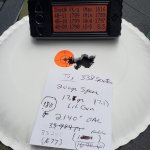 20241211_132607.jpg351.5 KB · Views: 17
20241211_132607.jpg351.5 KB · Views: 17 -
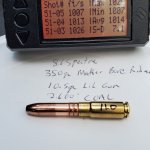 20250114_151218.jpg424.2 KB · Views: 17
20250114_151218.jpg424.2 KB · Views: 17 -
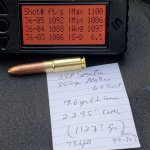 20241202_141251.jpg559.1 KB · Views: 14
20241202_141251.jpg559.1 KB · Views: 14 -
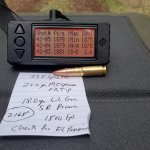 20250107_142129.jpg705.5 KB · Views: 15
20250107_142129.jpg705.5 KB · Views: 15 -
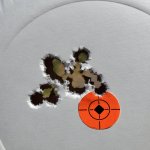 20230720_153004.jpg611.2 KB · Views: 16
20230720_153004.jpg611.2 KB · Views: 16 -
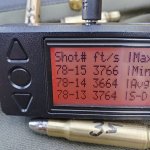 20230720_152614.jpg657.4 KB · Views: 19
20230720_152614.jpg657.4 KB · Views: 19 -
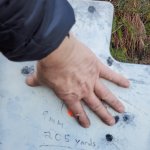 20210313_161135.jpg377.4 KB · Views: 15
20210313_161135.jpg377.4 KB · Views: 15 -
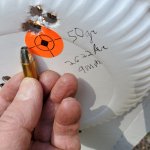 20230425_160934.jpg392 KB · Views: 19
20230425_160934.jpg392 KB · Views: 19 -
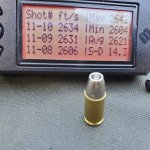 20230425_161612.jpg839.1 KB · Views: 19
20230425_161612.jpg839.1 KB · Views: 19 -
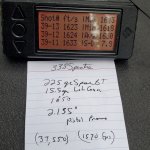 20241211_130507.jpg680.5 KB · Views: 17
20241211_130507.jpg680.5 KB · Views: 17
Similar threads
- Replies
- 5
- Views
- 205
- Replies
- 23
- Views
- 1K
- Replies
- 29
- Views
- 1K
- Replies
- 6
- Views
- 428

